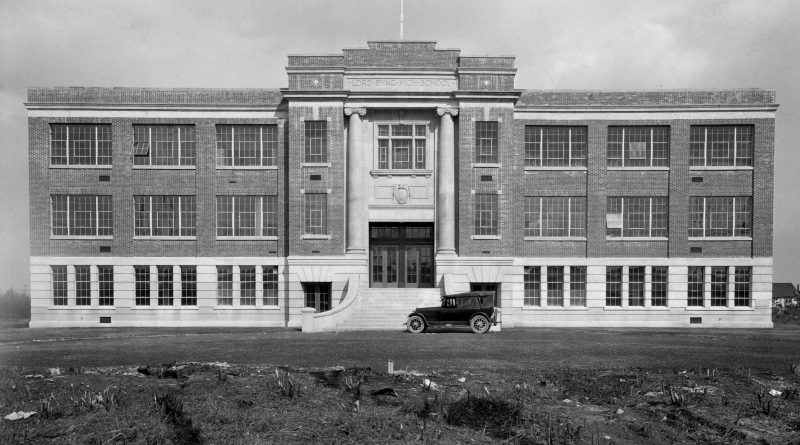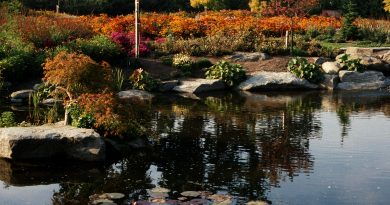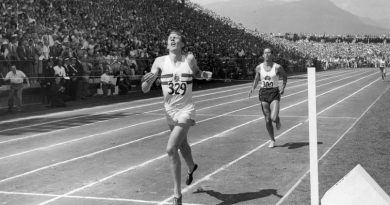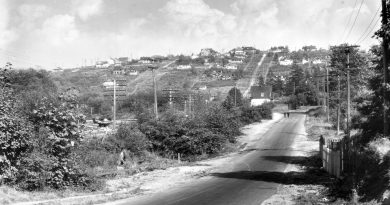1925
Above: The Lord Byng Secondary School was completed in 1925.
[Image: VSB Archives & Heritage]
*****************************************
You’ll note that these years include events listed under “Also in . . .” These are events for which we don’t have a specific date. If YOU know the specific date of an event shown there, please notify us . . . and cite the source! Many thanks!
*****************************************
January 4 Broadcaster Earle “The Pearl” Bradford was born.
January 5 (Included only because of the accused’s age) Newspaper report: “Bail in a dope case will be set at $5,000. L. O’Neil, 87, is to be arraigned before Magistrate Findlay in Police Court and charged with trafficking in narcotics under the Drug Act. Police will state that O’Neil did a brisk trade with a number of women, the tip to his activities coming from three women arrested recently. A quantity of morphine and cocaine valued at $300 will be in his possession when arrested.”
January 8 A man is attacked by a shark in the First Narrows.
January 17 The first organized game of football was played in Vancouver. Two teams, one junior and the other senior, were put together at the University of British Columbia. The juniors were the first into the field of play, beating a team named the Tillicums 17-5. The seniors followed a week later, losing 7-6 to St. Mark’s, the campus theological college.
February 7 Eleven crew members, returning to the Imperial Japanese ship Idzumo, drowned in fog-choked Burrard Inlet after their small ship’s boat collided with a barge. A memorial service was held February 11 at Wesley Church.
March 16 Broadcaster Jack Kyle was born.
March 20 The racist and anti-Catholic, anti-Jewish, anti-trade-union Ku Klux Klan, which started in the southern United States, had and has its followers in Canada. The Klan was strongest in Saskatchewan in the late 1920s, but there was a chapter in Vancouver in 1925. The Klan popped up in the news today, says writer Ed Starkins (Who Killed Janet Smith? is his book on that famous Shaughnessy nursemaid murder), when vigilantes dressed in their hooded apparel kidnapped a Chinese houseboy who worked in the house where the murder occurred. “For six weeks,” Starkins writes, “he was shackled to the floor of an attic room in Point Grey, and subjected to frequent beatings and death threats” to try to force out the name of the killer. They finally let him go when they realized he was innocent.
March 23 Wilson Duff, anthropologist, was born in Vancouver. His entire career would centre on the study of Northwest Coast Indians.
March 31 The Vancouver Sun published a Progress And Prosperity Number.
March For five months Lord Byng students had been attending classes in the nearby Lord Kitchener School building. They moved into their now completed building this month. This is also the year that Lady Byng donated the cup named for her, and given each year to the NHL player who combines sportsmanship with excellence.
April 6 Sam Greer died, aged about 82. In 1882, this pugnacious 39-year-old Irishman (his nickname was “Gritty”) established a farm on 65 hectares of land at Kits Beach. It came to be called Greer’s Beach. But the land wasn’t his. It was the province’s, which in 1884 gave it to the CPR. Now Sam, his wife and their six kids were squatters. He refused to move. In 1887 the sheriff came, and Sam shot the sheriff. While that official healed Sam and his family were ousted, his buildings levelled, and he spent some time in jail.
May 2 Broadcaster Monty McFarlane born.
May 7 The Beaver memorial at Prospect Point was unveiled.
May 19 The provincial government is selling lots at University Hill.
May 23 Burnaby’s first May Day celebrations were held in Central Park. A ballot system picked a May Queen from the candidates put forward from each school. The first May Queen was Ruth Bearn. Festivities included a parade, Maypole dancing, school sports and the crowning of the Queen. The annual event continued, with one interruption because of World War II, until 1961.
June 10 The United Church of Canada was born, a union of the Congregationalists,
Methodists and two-thirds of the Presbyterians of Canada. That day it became the largest Protestant Christian church in Canada. An inaugural service was held today at St. Andrews Presbyterian in Vancouver to celebrate the union, the first United Church service in Vancouver.
June 12 The Sun had an item on Page 2 about “Vancouver Day.” The Province followed with a story the next day. This first tribute to the city’s pioneers (June 13 was chosen because it was the day in 1792 on which Capt. Vancouver explored Burrard Inlet and the date in 1886 on which the Great Fire occurred) was marked by the unveiling of a drinking fountain at the corner of Carrall and Water Streets, “where once stood a great maple tree.” In a speech by Mayor L.D. Taylor he said that the event would be marked annually. But there’s no other reference to the day until June 13, 1929, four years later. And the 1929 report seems to be the last time Vancouver Day was heard of.
August 11 Radio CNRV began broadcasting from a studio in the CNR train station. The railway ran a national network heard on its trains all across the country. It will eventually become the CBC!
Also August 11 A 20,000-ton floating dry dock at Burrard Dry Dock in North Vancouver was opened by J.H. King, federal minister of public works.
September The Vancouver Oil Refinery was established at First and Bewicke in North Vancouver.
October 1 The Vancouver School of Applied and Decorative Arts opened its doors. Today, it’s known as the Emily Carr Institute of Art and Design. (The genesis of the institute had been in 1920, when a group of artists, educators, and art patrons formed the British Columbia Art League to lobby the provincial and city governments for a school.)
October 17 On September 8, 1925 the Ford Motor Car Co.’s chief photographer Edward Flickenger and Dr. Perry Doolittle, founder of the Canadian Automobile Assn. and called the father of the Trans-Canada Highway, left Halifax in a brand new 1926 Ford Model T. They drove the 4,794 miles (7,715 km) across Canada and arrived in Vancouver today. It was the first time an automobile had travelled completely across the country. For 500 miles they had to fit the Model T with railroad wheels because there was no road!
October 23 Johnny Carson was born.
October 29 Nathan Divinsky was born.
October 30 The Invisible Empire of the Kanadian Knights of the Ku Klux Klan paraded en masse up Granville Street to take up residence in their gorgeous new headquarters, the Shaughnessy mansion known as Glen Brae. They held an “informal reception” there today. “They paraded on the grounds in their white robes,” one neighbor recalled, “carrying fiery crosses of red electric lights. We saw them coming in their white hoods with the black eyeholes. It left a very lasting impression.”
KKK membership in Vancouver was said to be 8,000 at its peak—this is likely an exaggeration. At any rate, a local bylaw was passed prohibiting mask-wearing and the number of Klan members dwindled to about 200. The sheeted twits were out of Glen Brae in less than a year, even though their rent was only $150 a month.
Today Glen Brae has a nobler use: It’s Canuck Place, the hospice for children.
November 2 A story in the Province told of plans to construct, on Grouse Mountain, the Dominion Marine Observatory. It would be built, said the story, “when the highway to the top of the mountain is completed.” It was to have been financed by “Mr. Edward Mahon, well-known English businessman.” He would pay for the installation of the Mahon reflecting telescope which, thanks to “the clear and steady atmosphere” on the mountain, would “place the observatory at a single bound in the very forefront of the famous observatories of the world.” The highway was finished in the spring of 1927, but nothing more seems to have been heard of the project.
November 4 Canadian National diesel electric car No. 15280 completed a run from Montreal to Vancouver today in a total elapsed time of 72 hours and an actual running time of 67 hours 7 minutes. (Compare that to the 39 days taken by the automobile. See October 17.)
November 7 Before the Ironworkers Memorial, another bridge crossed Burrard Inlet at the Second Narrows. The North Shore municipalities joined to finance the project, and The Vancouver Morning Sun of November 6, 1925 devoted great swaths of print to the bridge, which would open to traffic the next day. (3,000 cars would cross it on opening day.) Special coverage in the Sun story was given to chief engineer William Smaill, who also designed the bridge. “To his skill and experience,” the Sun wrote, “was due, to a very great extent, the outstanding success that attended the work from the start to the finish.”
Not quite. The place beneath the bridge where marine traffic was directed was in the shallows nearer the shore, rather than out over deeper water. A barge going under on September 13, 1930, at low tide, would get stuck beneath the span. Witnesses looked on in helpless horror as the tide began to rise, the barge began to crush against the bridge, and the bridge began to buckle. No one was hurt, but the span was put out of commission for four years.
It was hit often by ships (three even before the barge incident), and came to be known as “The Bridge of Sighs.” It would be gone by 1970.
November 15 Our Lady of Perpetual Help opened.
December 13 Alderman and civic official Fritz Bowers was born.
December 22 Mike Ferbey of the Rhythm Pals was born.
Also in 1925
The UBC campus finally opened at Point Grey.
UBC granted its first honorary degrees.
The Main Library at UBC, one of the oldest on the campus, was built. It is the largest library in BC, and open to the public.
The Chemistry Building was built at UBC. Its modern Tudor style is reminiscent of buildings found at Oxford and Cambridge Universities. Originally, all the university’s buildings were to be done in this style, but the B.C. granite exterior was too expensive—and only three buildings were faced with this stone (Chemistry, the Main Library, and Hennings).
20-year-old Walter Gage earned his BA at UBC. His 50-year association with the university will culminate in his retiring as president in 1975.
Gordon Shrum (born in Smithville, Ontario June 14, 1896) drove from Toronto in a Model T to teach at the physics department at UBC. He was 29. He would be there for nearly 40 years, head the department for 23 of them. For more on this remarkable character, go here.
Burnaby’s first fire department, made up of volunteers, was formed in South Burnaby. The Chief of Police also acted as Fire Chief.
By special arrangement with the Hudson Bay Company, 4-point blankets were sold to tourists for $18 a pair at the gas station at Fry’s Corner (junction of Fraser and Pacific Highway in Surrey).
Arthur Whalley opened a service station, general store, and soft drink stand in Surrey. When Pacific Stage Lines opened a bus stop there they called it Whalley’s Corner. The name Whalley would be officially adopted in 1948.
The Devonshire Hotel opened at the northeast corner of Georgia and Hornby Streets. (On July 5, 1981 it was brought down in a spectacular controlled explosion.)
A striking monument to Japanese-Canadian soldiers who fought for Canada in World War One was constructed in Stanley Park. (During World War One, 196 Japanese-Canadians volunteered to fight for Canada. At Vimy Ridge, fought over four days in April, 1917, one of them, Sergeant Masumi Mitsui of Port Coquitlam, led his troop into battle with such distinction that he was awarded the Military Medal for Bravery. Of those 196 volunteers, 145 were killed or wounded.)
L.D. Taylor got elected mayor again. See mayors of Vancouver.
Fred Deeley, Sr., who had opened Fred Deeley Ltd. in a 12-foot-wide store at 1075 Granville in 1914, now owns a motorcycle shop, a bicycle shop, and one of Canada’s larger car dealerships.
Albert O. Koch, called the “Father” of Congregation Beth Israel, came to Vancouver in 1925 from New York via Montreal and at age 31 launched National Dress Co., Vancouver’s first garment manufacturing plant.
The Giant Dipper roller coaster began at Vancouver’s Hastings Park. It cost $65,000. It was almost a mile long, and the cars reached 40 miles an hour. The longest sheer drop was 60 feet. (It would be torn down March 6, 1948 to make room for extension of the race track.)
The Point Grey Gazette, in a 1925 Progress edition, says there was nothing in Point Grey between 16th Avenue and the Fraser River “other than the few scattered houses in that corner of the municipality bounded by Oak, Cambie, 16th and King Edward.” (King Edward is equivalent to 25th Avenue.) In other words, there was nothing between King Edward and the Fraser River but forest. The article refers to the “Muskee-Ehm Indian Reserve.” (Point Grey Municipality was created in 1908, merged with Vancouver in 1929.) The editor, by the way, was Earle Birney.
Rudolph Valentino came to judge a tango contest in “the big dance pavilion near Stanley Park.” (From Ivan Ackery’s memoir Fifty Years on Theatre Row.)
Jack Loutet, a notary in North Vancouver, and Eades Ward founded the Notaries Public Association of British Columbia. There were approximately 1,000 Notaries in BC. Read more here.
The Dominion Motors Building was built at 901 Seymour Street. Today, it’s a heritage structure.
The Connaught Park Fieldhouse was built at 2390 West 10th. Another heritage structure.
Adam Urias dePencier, Anglican priest, became the Archbishop of New Westminster.
Dal (Albert Edward) Grauer, 19, earned his BA at UBC. He will become president of the BC Electric Railway in the 1940s.
Vancouver’s Jack (John Edward) Underhill, 23, became Canada’s top male badminton star, won numerous B.C. and national championships over the next two decades.
A group of squatters in Stanley Park, with one exception, lost their appeals against eviction. (The city had launched legal proceedings in 1921.) They were allowed to remain in their homes for a fee of a dollar-a-month until they were finally evicted in 1931. The Vancouver Fire Department burned down their homes. The Cummings family at Brockton Point had refused to take part in the legal proceedings, upset they had not been consulted when the land had been turned into a park. The Parks Board agreed to let the family stay for a $5-a-month fee. They lived in their squatted home until their deaths: Agnes Cummings died in 1953 at age 69, and Tim Cummings died in 1958 at age 77.
26-year-old Ivor Ackery gets a job as an usher at the Capitol Theatre. Ten years later, as Ivan Ackery, he would become general manager of the Orpheum Theatre, a job he would hold for more than 30 years.
A. McC. Creery became president of the Vancouver Real Estate Board.
Melville Dollar became president of the Vancouver Board of Trade.
Eric Hamber, head of BC Mills Timber & Trading, sold the company to the Vancouver Harbour Commission for $2.45 million.
The Koo family established what is now J.B. Hoy Produce, a family-operated store in the Kerrisdale neighborhood of Vancouver, where operators wear white smocks to set out the veggies.
One of the minor characters in the 1925 Lon Chaney movie treatment of Phantom of the Opera was Vancouver choreographer Aida Broadbent.
Charles and Martha Lovell moved from Agassiz to Port Coquitlam. They are mentioned here because they raised five daughters, named for the flowers their mother loved: Daisy, Rose, Lily, Violet and Pansy.
R.C. “Harry” Galer, who had been a hard-working alderman on Port Coquitlam council for several years, was elected mayor. (The R.C. stood for Roger Charles.) Immensely popular, he would be PoCo’s mayor for 20 years. He died in 1968 at age 94.
Vancouver’s Locarno Crescent was named this year in honor of the Locarno Pact (1925), the outcome of a multi-national conference on the establishment of guaranteed borders in Europe. Locarno is a town in Switzerland.
Michael Kluckner, author of many splendid books on local history, wrote in The Greater Vancouver Book: “South and west of King Edward Avenue as far as the Quilchena hillside at 33rd, the land was marshy bushland known as Consumption Hollow, Asthma Flats or Johnston’s Farm. It was leased in 1925 to the Quilchena Golf Club, which had a clubhouse at 29th and Maple Crescent, and a small interurban station for golfing passengers!”
St. Philip’s Anglican Church in Dunbar/Southlands was built.
The American Can Company Building at 611 Alexander Street, admired by architects, was built. It would be rehabilitated by architect Bruno Freschi in 1988.
The Hebrew Athletic Club was established.
Construction began on eight-room Quilchena Elementary, in the 5300-block Maple. “Quilchena” means “land of many waters,” a name chosen because of the abundance of little rivers and bogs in the area.
Arthur “Sparks” Holstead, who had been granted a licence to operate a 10-watt radio station, CFDC, in Nanaimo in1923 brought the station’s transmitter to Vancouver in a suitcase, and went on the air. The federal government’s broadcasting regulatory agency objected and ordered him off. Public petitions demanded its return, and the station signed back on. In 1928 Holstead would change the station’s name to CKWX.
One-year-old Pacific Airways, under its founder Don MacLaren, operated its upcoast fishery patrols from a flying-boat base at Jericho Beach.
Aero Garment Ltd. was founded, Vancouver’s largest privately-owned clothing manufacturer.
Author Donald MacKay was born in Nova Scotia.
Film historian Michael Walsh writes that The Winds Of Change, a 1925 drama directed by Frank Lloyd, began the tradition of Hollywood producers filming on location in Vancouver. The movie was a gold-rush melodrama in which Capilano Canyon stood in for the Klondike.
Mountaineers Don and Phyllis Munday climbed Mount Arrowsmith on Vancouver Island. From the summit they spied a huge peak in the distant northeast, towering above all its neighbors. Their resolution to reach “Mystery Mountain” resulted in years of expeditions around what is now called Mount Waddington—at 13,177 feet the highest point wholly within B.C.
Harold Merilees, called Vancouver’s first great ad man, began at Spencer’s department store’s advertising department.
Richard Cormon Purdy, who had started his chocolate business in 1907, sold the firm to Hugh Forrester. (Forrester sold it to Charles Flavelle in 1963.)
The first neon sign on Granville Street flickered on in 1925.
The old (1898) three-storey Hudson’s Bay store at the northeast corner of Granville and Georgia was torn down and a new building went up, a building exactly matched to one put up by the Bay in 1914, and continuing its cream terra cotta facing and Corinthian columns. It’s difficult—if possible at all—to tell where the 1925 building joins to the 1914 one.




